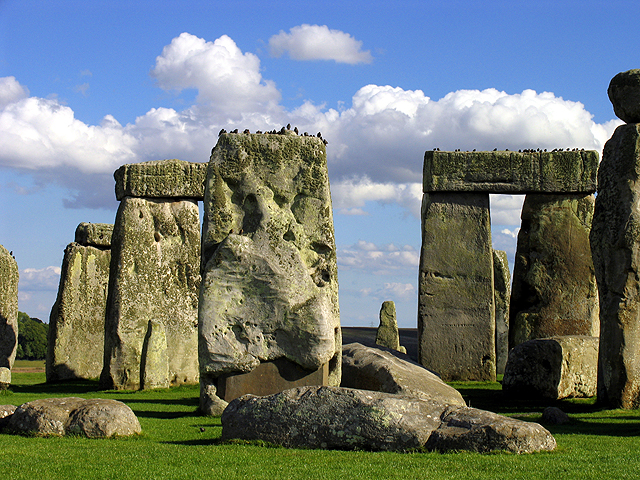
.Thanks to the Bird’s Resting Place: Stonehenge (Pam Brophy) / CC BY-SA 2.0
Notice the abundance of passing visitors on the wing. Birds like to have a safe place to perch, or indeed to roost overnight.

Close-up
Is what we are seeing here merely an incidental feature of Stonehenge and similar sites with standing stones, including the simpler ones at Avebury?
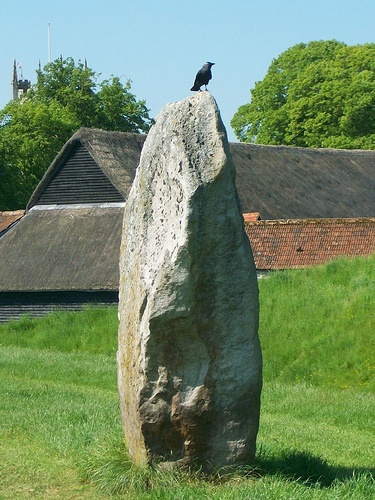
Crow at Avebury (single standing stones, no lintel cross-pieces).
This blogger/retired scientist, with an insatiable appetite for unsolved enigmas (Turin Shroud , or biogenesis of life on Earth etc) says NO. The attraction of those Neolithic standing stones to birds, carrion feeders especially, was NO ACCIDENT. They were set up specifically for that purpose. But there had to be an added attraction – food as well as a place to rest.
So what was the source of food?
Well, here’s where the discussion gets a little difficult.
Long, long before our Neolithic (late Stone Age) ancestors were farming the chalk uplands of Wiltshire, their ancestors, the forest-dwelling hunter-gathers were confronted with an age-old problem – how to dispose of the dead, efficiently, while leaving some permanent memorial. However, being pre-Christian pagans they had preoccupations of their own, ones that may no longer seem obvious to the modern mind. Like how should the body be handled so as to permit release of the soul, i.e. spirit? Here’s where things get even more difficult: apparently the mortal flesh of the body was considered to be an impediment to escape of the soul. Anything that removed flesh from bone, no matter how off-putting a sight in the short term, provided peace of mind to the living, consonant with peace and immortality for the dead. A number of ploys, strategies were available, the details of which need not concern us right now. Suffice it to say that a popular one that existed in ancient times, and which survives to this day in various parts of the world, was the so-called “sky burial”.
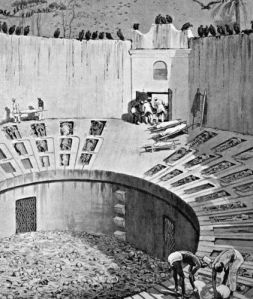
Artist’s portrayal of an Eastern ‘Tower of Silence’ . Note vultures at the top, cleaned bones in the central well.
(To keep this posting of a reasonable length, I’m assuming the reader is broadly familiar with the meaning of ‘sky burial’, still extant in some parts of the world under alternative names, e.g. “Towers of Silence”. If not then see the image above, and maybe the wiki entry on sky burial too)
Recent excavations in the Sussex Weald (see link below) uncovered these structures which date back to 4000 BC or earlier. They are considered to be places where the dead were laid out for excarnation (defleshing).
![Fig. 7 photograph of square enclosure[15]_0](https://sussingstonehenge.files.wordpress.com/2016/04/fig-7-photograph-of-square-enclosure15_0.jpg?w=300&h=246)
Designed for excarnation of the dead (“defleshing”) by birds?
Quote from the Historyextra site that supplied the above photograph (my bolding) :
“The composite arrowheads we found show that people were exploiting the woodland. And we suspect the small square enclosure that we discovered – a gully around a square, raised platform – was used as a mortuary.
“We think the dead would have been laid out for birds to pick off the flesh. We suspect this is a Neolithic structure, dating to 4,000-2,000 BC.
Yes, opportunist feeders, especially massed scavenger birds, would have been considered agents par excellence for accomplishing an unpleasant task with maximum dispatch, least bother.
In passing, the title for this posting originally specified “carrion crows” as the likely scavenger. On reflection, one must not overlook another species that is highly adaptable – namely the seagull (especially herring and lesser black-backed gulls). In modern Britain they used to come far inland from their normal coastal habitat, being attracted by the rich offerings of landfill sites (probably less so now with separate kitchen-waste recycling via biogas plants).

Seagulls, landfill site, Gloucester, England (from BBC).
Their adaptability re nesting sites is legendary.

Inland seagulls and their squatting tendency
Might safe and secure nesting exolain why the builders of Stonehenge went to so much trouble to make the stones secure, with both mortise-and-tenon AND tongue-in-groove joints?
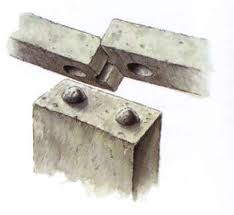
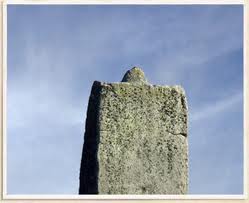
One would’t want the lintels rocking even ever so gently if wishing to attract a year-round resident population of feathered-friends …
So how does the idea of Stonehenge as a site for ‘sky burial’ fit in with nearby Neolithic sites (notably Durrington Walls and Woodhenge)? That grouping is full of possible interpretations and scenarios, some already broached here and on the writer’s sciencebuzz site some 4 years ago, notably in connection with wintertime communal feasting of young pigs. Let’s not be too quick to make sense of a welter of competing information. Let’s go some 25 miles north of Stonehenge to another iconic grouping of Neolithic sites, all under the care of English Heritage, namely Avebury Henge and Stone Circle, Silbury Hill and West Kennet Long Barrow. Here’s a Google map showing their close proximity to one another:
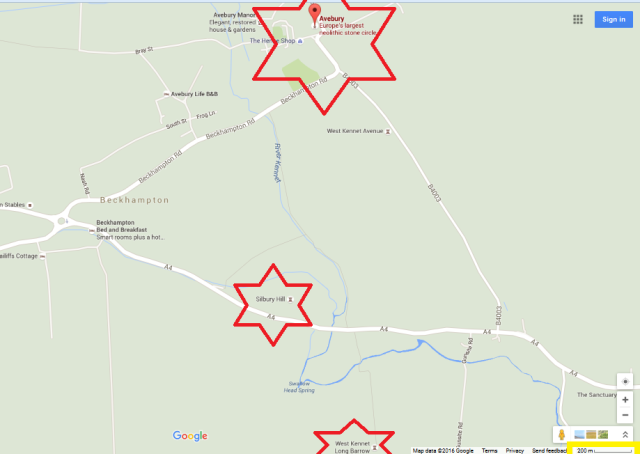
The red stars show the locations of Avebury (top), Silbury Hill (centre) and West Kennet Long Barrow (bottom). Note the scale (bottom right, highlighted in yellow) – a mere 200 metres.
Here’s a list of approxiamte datings for the major Neolithic sites in Wiltshire which this non-historian has culled from different internet sources, and is happy (until told otherwise) to take on trust:
APPROXIMATE TIMELINE
West Kennet Long Barrow: 3650BC. Finally decommissioned approx. 2500BC
Avebury stone circles: 2750 BC (as late as 2400BC for the linear avenues).
Stonehenge 3 (II) from wiki – sarson arrival: 2,600 – 2,400 BC but continuing later with arrival of bluestones.
Durrington Walls: 2525 – 2470BC
Marlborough Mound/Marden Henge: 2400BC
Silbury Mound : 2400-2300 BC
Woodhenge: 2300BC
So here’s a scenario that might have been operating in approx 2,500 – 2,300 BC, initially involving Avebury and West Kennet Long Barrow, and later involving the approximately midway upstart ‘cardionecropolis’ (yup, my description) that we now call Silbury Hill.
Someone in the community dies, possibly a respected figure, deserving of a ‘proper send-off’. Cremation? No, oh-so-last millennium, wasteful of increasingly scarce firewood, needed for cooking and heating. Simple burial? No, ruled out on both practical and religious grounds. Chalk bedrock in the Wiltshire downs, with no metal implements, merely antler picks, makes burial laborious and time-consuming. But there’s an age-old fear re burial – might it not prevent the soul exiting from the buried, mortal remains to the skies above? Solution: transfer the body to Avebury, taking a basket of local turves and soil fauna (earthworms etc) from the deceased’s home patch to our putative excarnation site where it’s handed over to specialists. The first thing they do is excise the heart (thus the two smoothed-off flint-sharpening stones at the southern entrance to Avebury) which is enveloped in the turves, then tied around with plaited grass or string to create a compact receptacle for interment (see posting immediately previous to this one). The grieving relative says a temporary farewell to the departed, walks the short distance to Silbury mound where the package is interred behind a sarsen stone at a spot decreed by Silbury’s guardians. Meanwhile back at Avebury the corpse minus heart is laid out for excarnation by the resident bird population. Days, probably weeks later the bereaved returns to collect an ensemble of relatively clean bones. They are then taken home for safe-keeping and veneration OR in the case of VIPs maybe transferred to West Kennet Long Barrow, or one or other similar temporary repository for bones, maybe for months, possibly for years. (It does appear there was a steady coming-and-going of bones/dislocated skeletons at West Kennet, which ceased with the arrival of the final consignment of bones).
The next task is to fit that other grouping Stonehenge/Durrington Walls/Woodhenge into a coherent framework based around excarnation as the preferred option for disposal of the dead. In fact an attempt was made to do just that on both this and the writer’s sciencebuzz site, introducing a new concept that I termed ‘secondary necrophagy‘. It seems such a waste of ‘disposable’ high class protein to feed it to wild, undomesticated birds. Why not comminute it, and use it to keep captive pigs fed in the winter months especially? Response/feedback to that idea? Zilch! Ought one now to try a second time, especially if the arguably less gut-wrenching ideas re Avebury and Silbury were hopefully to gain some traction? Only time will tell. This writer is in no hurry to ‘sew up the story’. Neolithic Britain is not the kind of topic that can be neatly sewn up in a hurry…
Here’s a final image, just discovered. Try to imagine those starlings (?) are crows or seagulls. Regardless of species, they clearly appreciate their ‘bird’s eye view’ of Stonehenge and Salisbury Plain.
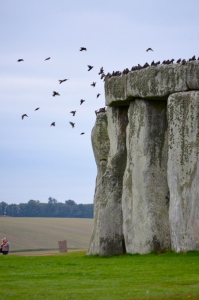
Colin Berry PhD
April 17, 2016.
Herts. UK
sciencebod01(at)aol.com
Next posting? Isn’t Stonehenge supposed to have served primarily as an astronomical calendar, signifying the longest day in summer (or shortest day in winter)? Isn’t it asking a lot to suggest it was dual purpose? And what about those bluestones, carried all the way from the Preseli mountains in west Wales, whether by glaciers or by human beings? Why the preference for bluestones for STONEhenge Mk1 (arranged in 2 concentric arcs we’re told) over local sarsens (silicified sandstone) – the latter present in abundance in Wiltshire while scarcely getting a look-in where Mk1 Stonehenge was concerned?
Both those key questions will be addressed.
Update: April 18: here’s a link to a new posting on my sciencebuzz site:
Why the need for all those Neolithic standing stones at Stonehenge and Avebury? Why were igneous bluestones required from the distant Welsh mountains?
New update: Monday April 25: see new posting on my sciencebuzz site:
Stonehenge can be thought of as a Flintstone-era funeral parlour. Its sales pitch was soul-releasing sky burial AND, by way of bonus, a compact take-away package of cremated bones.
New update: Friday April 29:
Ideas are evolving rapidly. See the latest posting on my sciencebuzz site:
Might Stonehenge have been designed as an easily-spottable feeding station for high-flying seagulls – as perhaps was the nearby “Cursus”?
Photo-archive (placed here to avoid overloading my current sciencebuzz posting, 23rd May, 2016).
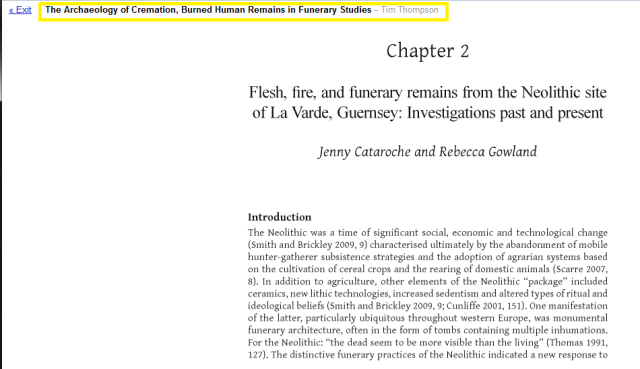
Archive 1: more details later
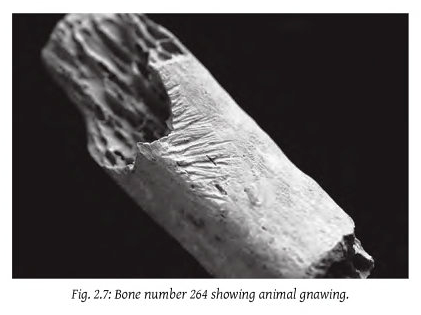
Archive 2- more details later
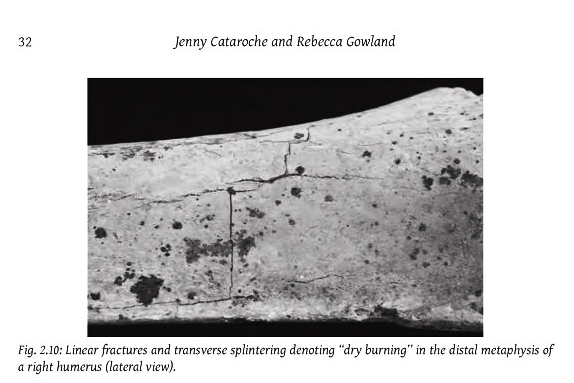
Archive 4 – more details later.
………………………………………………..
Addendum: March 16, 2018
Have decided to add the following image as an addendum to ALL my Stonehenge postings (some 24 in all, here and on my sciencebuzz site). Why not – since it’s my considered answer to the ‘mystery’ of the monument’s peculiar architecture, the conclusion to some 6 years of deliberation?
Reminder*
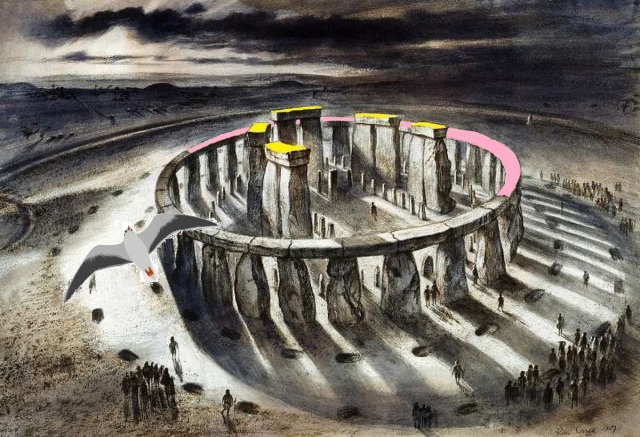
I say Stonehenge was designed as a giant bird perch, a ceremonial monument dedicated to ‘sky burial’, i.e. soul release from mortal remains to the heavens via AFS (avian-facilitated skeletonization, considered the height of fashion (and practicality) in Neolithic-era 2500BC! The stripped remains were then cremated, so an apt description of Stonehenge might, as previously suggested, be PRE-CREMATORIUM.

Thanks for the corrective, Scott. I don’t doubt your word for one moment. Nothing about the internet surprises me in the slightest. You are Chicago-based!
I once spent an interesting few days in your lake-side city, attending a science conference. I was most impressed with Chicago (finding it a distinct improvement on Philly, where I was based for two years at the University Hospital School of Medicine). Fortunately I and (then) new wife lived out near the far end of the Main Line (Devon) which made the early evening exit via rail from Philly centre something to look forward to.
Who was it whose gravestone said “I’d rather be here than Philadelphia”. W.C Fields?
Yes. W.C. Fields said that. At least that’s the legend. He’s one of my all time favorites. When you were in Chicago did you visit the museums? Science and Industry? My favorite was always the Field Museum of Natural History. Been there countless times. Oh…it’s named after Marshall Field not W.C. I live up here because of my job. I grew up in the country. Small towns. I prefer that to the big city life. Too crowded, noisy and hectic. I’m currently sitting at home reading and researching waiting for the hysteria to abate so I can return to a productive life.
Thanks for the follow-up reply Scott (for which WordPress did not supply a Reply tab). I shall try to find time to read your link later today. In the meantime, you might like to see this passage which I’ve copied from the official Guide to Stonehenge which I purchased some 10 years ago when making my 3rd visit. (I’ve also researched man-made Silbury Hill:which you say is also of interest: Ancient Origins published my novel ideas re its piecemeal development over the course of a century or so. I can supply links if you’re interested in off-the-wall ideas!)
Anyway, here’s that passage, copied verbatim from Page 31 on the Stonehenge Guide:
English Heritage: Stonehenge. Julian Richards (2011 edition)
History: Before Stonehenge
“Stonehenge was not the first structure to be built on this part of Salisbury Plain. Excavations carried out in 1966 and 1989 in the area of the present car park revealed four large pits, all of which showed convincing evidence that they had originally held large timber posts of about 75cm (30in) in diameter. The wood that was used for the posts was identified as pine – an unusual tree to be found on chalk soils -but the date of the posts was even more unexpected. Radiocarbon dating showed that this was between 8500 and 7000 BC, in a period known as the Mesolithic or Middle Stone Age. This was not long after the end of the last Ice Age, when Britain was still connected to mainland Europe.
As sea levels rose in the warming climate, trees grew: initially pine and hazel. Within this forest, in river valleys and on seashores, bands of hunters and gatherers lived on wild foods. It was these people who raised the posts, perhaps best interpreted as poles of the kind found on Native North American sites, commonly known as totem poles. These structures, more than 9,000 years old and built so close to Stonehenge, are unique. There is nothing else like them in the British Isles from this ancient time.
Several thousand years later, by about 4000 BC, people has begun to tame the wildwood – the mixed forest of elm, oak and hazel that had replaced the earlier pine forests over much of mainland Britain. Using stone axes to fell trees and fires to create clearings, they opened up spaces in which they could farm. Unlike farming today, with its large fields and neat hedges, small cleared areas were carved out of the woods to grow cereals such as wheat and barley; there were also domesticated animals: cattle, pigs and sheep.
Farming, even on a small scale, brings stability and ties people to the land: it was at this time, between about 4000 and 3000 BC, that communal efforts resulted in the building of the first ceremonial monuments and burial mounds. Some upland chalk areas, like that around Stonehenge, may have had more of these sites because they remained comparatively free of woodland. The causewayed enclosure known as Robin Hood’s Ball, to the north-west of Stonehenge, was built at this time, as were both Cursus monuments and probably most of the long barrows in this area.”
PS: Scott gave a link to the megalithicbuilders site home page, with no detailed info on the history of Stonehenge (apart from the link to the video clip). I think I have found the specific article he wants us to read:
https://www.megalithicbuilders.com/europe/england/wiltshire-stonehenge
It’s long and very detailed, but my first impression is that it has little to say on the question of whether early uncleared forest had much role to play in the early stages of Stonehenge. On the contrary, it suggests that the site in and around Stonehenge was relatively free of forest even as early as 3000 BC, long before the sarsens arrived (while acknowledging that bluestones may have been a much earlier arrival). I’ll give the link a more detailed scrutiny before commenting further on whether it undermines my own thinking or not regarding all 3 of my models, from Model 1 (sky burial) through the real reason for bluestone transport from Wales (Model 2, (semi-portable blockhouse) to current/final Model 3 (winnowing platforms).
Hi Colin. Thanks for getting back to me. I’ve read what you sent. Don’t know where I saw it. I read so many things. I’m a reader. Hate TV. Stonehenge perhaps being started in the Mesolithic was interesting. I suspect the people who laid it out then may have been from Doggerland? I’ve read the oldest stone circles first appeared in northwest Scotland. I found that odd. Why there? I thought refugees? Reestablishing their society? Refugees from where? Again, I thought Doggerland. Or maybe North America? Silbury Hill originally being chalk covered. White. Must have gleamed in sunlight. My mind thought Giza. Casing stones of polished limestone. Again, gleaming in the sun. I’ve read between the tin in Cornwall and gold in County Wicklow, there was contact from Egypt. Evidence. Seafaring is far older than usually admitted. Late Paleolithic/Early Neolithic. Evidence from middens containing distant deep water species.That tells me larger ships perhaps forerunners of curraughs? It shows navigational skills, knowledge of where you’re going and how to get home. Knowledge of at least latitude. I could go on. Anyway. The cite I sent you mentioned forests in 4000 BC. But the area was in use much earlier. And when it comes to my looking into ways of life in Neolithic or before. I always use knowledge gleaned here in the US about the Indian way of life. Where I live, Chicago, Stone Age people were here not thousands of years ago…but a mere 200-250 years ago. I see I have rambled on far longer than intended. Bye for now. .
Speaking as a boring old scientist, Scott, long since retired, might I make so bold as to give you some unsolicited advice. FOCUS (circumstances permitting), on just one thing at a time! Like whether the surviving presence or later absence – if only in parts – of original woodland cover at Stonehenge played any role in its immediate v long-term development, dare one say, multi-stage evolution. Oh, and whether or not surviving woodland does (or does not) rule out one model or another, my own included …
PS: My WordPress hit meter says you are presently S.Africa-based (not US!). 😉
Hi Colin. I at times follow one path. Sometimes it branches so I persue several. South Africa? Weird. Sorry to disappoint WordPress but I was born and raised in Illinois. Grew up 60 miles south of Chicago and now live about 10 miles from O’Hare airport. I have no reason to lie. Why? I guess my following several interests comes from a desire to learn. To put the jigsaw pieces together so to speak. I’ve never had a desire to follow a single path. Perhaps in fear I would never see any other. Again…the South Africa thing is odd. Wonder how that is? I’m not too tech savvy. Heck, I’m a white guy. Irish/German decent. Why the hell would I want to be in the hellhole at the bottom of Africa? But that is interesting.
Boring old scientist? I suspect classic British understatement. I appreciate your unsolicited advice. Advice is always welcome. I’m 60 and at times I get impatient. Quest for knowledge can be insatiable. I’ve learned more than enough to realize I know so very little. Any guidance or advice you can offer will always be accepted with humility and gratitude. And yes…I’m still in Chicago. That’s so odd. No, I don’t mean odd I’m still in Chicago…the South Africa thing. Oh well. I’m sure I could prove my whereabouts if needed. But I fear we drift from an exchange of ideas.
Here’s another comment that I left this morning on the sarsen.org site:
sciencebod12 February 2018 at 07:19
Thanks Neil. I realized afterwards it must be something happening elsewhere…
Just a quick note on possible logistics before this posting gets overlain with new ones (such a shame/annoyance that Blogger does not provide a “Latest Comments” list to all postings, past as well as present.
The aim was to perform the entire process in a 36 – 48 hour time span.
Here’s a possible sequence of operations
Day 1: body of deceased to be delivered after sunset. Necessary preliminaries (let’s not discuss details) took place during hours of darkness.
Day 2: prepared body placed on central spot shortly before dawn. Central zone then cleared of people.
The bluestones were then struck, the chimes attracting gulls and /or other avian scavengers from miles around.
The corpse was gradually stripped of most of its flesh throughout the daylight hours, at least at highly developed Stonehenge, Avebury etc, designed to attract and accommodate scores of scavenger birds. The soul of the deceased would be considered to have been released to the heavens (“sky burial”).
Come dusk, the skeletal remains would be collected up and dispatched to a nearby crematorium, probably outside the excarnation area, possibly outside the circular heaped-up bank.
Come nightfall, fires/pyres were lit, the largely-defleshed bones quickly and cleanly cremated, then later retrieved from the ashes.
Day 3: Relatives arrived to collect and take away cremated bones. While they would be aware of flocks of birds on the wing, coming and going, and indeed take comfort from that, they would be spared the sight of the central feeding area, that being screened off by the raised bank of the enclosure. (Indeed Mark 1 AFS relied almost entirely on the chalk bank of a causewayed enclosure, both as a screen and a man-made landmark visible to birds from afar, maybe with a few scattered timber posts initially as additional perches, later progressing to standing stones, then those mighty lintels.) Yes, the latter weren’t purely decorative – they served a purpose! Why so massive? Because that’s all that was available nearby as bridging stone. Thus the carpentry joints needed to prevent unwieldy sarsen stones from rocking, as well as a proto-Ikea aid to idiot-proof assembly.
Newly discovered Neolithic Datchet enclosure (announced just 3 days ago)
http://www.dailymail.co.uk/sciencetech/article-5371127/5500-year-old-Neolithic-monument-near-Windsor-castle.html
Why all the animal bones – domestic and wild – to say nothing of that severed human skull?
Can be accommodated with the AFS model! How? Beware: more speculation:
To be a workable proposition, the skeletonization would have to be speedy and efficient (relatives don’t want to be kept waiting too long for their take-home package). That means attracting and retaining a sizeable population of avian scavengers so there’s always a number of hopefuls on permanent standby – scores at least.
What if there’s a temporary halt in supply of mortal remains? Answer: one plugs the hiatus with animal remains, maybe feasting on the choicest parts before giving feathered friends the left-overs.
Thus the connection between feasting, animal and human bones… Just don’t ask about all those young pigs at the Durrington wintertime-feasting site!
PS:
PS: More on those Datchet animal bones (both domestic and wild animals):
The funeral centre had to be paid for its services. But how, given there was no money in Neolithic times as a medium of exchange?
Answer: you didn’t just turn up with your deceased relative. You brought an animal as well – either from your herd if a farmer, or from hunting expeditions into the surrounding countryside.
As I say, the mortuary attendants could feast initially on choicer cuts, maybe inviting the relatives and/or others to join them, and then use leftovers to ensure there was always something that would keep the avian scavengers on permanent standby.
Here’s my latest response to Neil Wiseman on the Sarsen.org site:
http://www.sarsen.org/2018/02/a303-tunnel-waste-plans.html
sciencebod, 11 February 2018 at 14:51
Hello again Neil
If anything to do with Sun or Moon, would there not have been a few markings on one or more stones, a point I raised earlier?
There is also the more general point that pre-stone circle/pre-henge farmers, those growing crops especially, would/must have had some crude kind of calendar at their disposal, and such a calendar would not have required massive stonework or even timber or chalk bank construction to figure out where one was in the annual cycle of seasons.
How? Imagine a farmer plonking down on a west-facing tree stump at the end of his working day, watching the sun set. He would be aware that the Sun sets progressively northwards up to a certain part of the year, with the longest day/shortest night , then stops, then moves back until reaching a new stop point much further south (80 degrees in modern terminology, i.e. the best part of a right angle).
Suppose now he counted the number of nights between what we now call the summer and winter solstices, by making cuts on a branch, or dropping small flints into a clay pot. He’d have found there were a regular repeating pattern of approx 182 nights, give or take between the solstices. Already he’d have a notion not just of days and nights (obviously) but now, more importantly, of years as well.
Months, notably lunar months? Yes, watching the phases of the Moon would serve, but why bother when it’s the warming Sun and seasons that are crucial to crops? Suppose then, dispensing for now with the Moon, our farmer decided to sow seed at the halfway point between the shortest and longest day, what we now call the vernal or spring equinox (arriving March 20 this year). He could do that crudely, by waiting for the Sun to set halfway between the two solstices OR, if wishing to be more accurate, could have waited until he had 90 or so notches or flints.
Why then go to the bother of constructing anything permanent simply to know where one is approximately in the passage of each new year when all that’s needed is a clear view towards the westward horizon (or alternatively the east-facing one instead if preferring to make his observations first thing in the morning?
What’s all this got to do with causeways, henges, standing stones, Stonehenge one might ask? I say nothing whatsoever – absolutely nothing. They were designed for an entirely different purpose, to do with giving dear departed relatives a respectful but efficient send-off to the afterlife, one in which an intermediary role for local birdlife was quickly perceived and accomplished by degrees, culminating in those mighty sarsen lintels (bird perches)for which it’s hard to see any obvious role where monitoring the annual seasons is concerned, or Sun or Moon worship etc etc.
I say that the summer/winter solstice theory is a false connection, one that should have been dispensed with long ago for lack of corroborating evidence and displaying, dare one say, a degree of fanciful or wishful thinking. It tries to make our Neolithic ancestors seem more detached from the problems of everyday existence than was really the case (like where the next meal was coming from, or what to do when Aunt Dot suddenly keels over, the ground outside is rock hard, the firewood nearly used up etc). Thank goodness for communal organization, or the first blossoming thereof.
Go visit the local (outdoor) funeral parlour, lit up at dawn if the sky is clear, thanks to its alignment in relation to sunrise and sunset. Those clever and methodical funeral directors have worked out a system. Call back a day or two later for an odour-free package of Auntie’s bones to add to the collection on their mantelpiece, or its Neolithic equivalent…
Don’t bother carving anything on the posts or stones. No one needs reminding what they are for…
(I’ll return with a separate comment later re the claimed ‘lithophonic’ properties of Stonehenge’s bluestones, once I’ve selected passages from that Royal College of Arts posting).
Cheers
ColinB
Have just posted this comment to another site.
http://www.sarsen.org/2018/02/a303-tunnel-waste-plans.html
sciencebod 10 February 2018 at 15:23
“Oh dear. This site is turning out to be such a disappointment – so few comments, so little feedback, despite the informative and authoritative nature of Tim’s postings.
Don’t get me started on some of the alternative sites – which invite comments, then tell one that the comment one has submitted must first be pre-moderated, that one is in a queue, but which finally never appears (with most other postings also devoid of any genuine-looking comments).
There is much that is wrong right now as regards the received ‘wisdom’ regarding Stonehenge (read dogma) and stone circles, henges etc in general where the internet is concerned (I could say more, but will hold my tongue for now).
It’s getting on for 2 years since I last posted on Stonehenge/Silbury Hill on my own two sites – some 20 postings in all between 2012 and 2016. None – and I repeat none – have been picked up by any number of those dubious sites – even on comments – this one excluded.
There seems to be a deliberate attempt at message-suppression (to which this blogger is no stranger, having attempted to ‘tell it the way it is’ regarding the supposedly ‘enigmatic’ Shroud of Turin these last 6 years!
Any chance of a guest posting on this site, one that briefly summarizes my near certainty that our Neolithic ancestors set great store, as well they might, by preliminary AFS (avian-assisted skeletonization) aka “sky burial” aka ‘defleshing’ aka excarnation as a preliminary to final bone cremation?
Those massive sarsen lintels were the high point of AFS evolution and technology – monumental bird perches if the truth be told – designed to attract and retain the nearest the British Isles have to the Eurasian vulture – almost certainly the adaptable and voracious seagull!
Sorry to keep banging on – but I have to say it again – the internet is not working as it should to disseminate new ideas. That’s thanks, I suspect, to vested interests of one sort or another… this site being mercifully free, if somewhat low profile right now , due one suspects to its emphasis on unadorned facts rather than bonkers (?)ideas…”
Colin Berry (aka sciencebod)
Have just this minute added this comment in reply to Neil Wiseman on Tim Daw’s sarson.org site.
http://www.sarsen.org/2018/02/larkhill-causewayed-enclosure-posthole.html#comment-form
It’s a summary of my belief that Stonehenge represents the technological pinnacle of Neolithic’s Britain’s pragmatic adoption of avian facilitated skeletonization (aka excarnation, aka “sky burial”) as a preliminary to final bone cremation. (NB: bone, as distinct from whole body cremation!)
1. Causewayed enclosure- multifunctional, being demarcation of homestead territory, with funeral facility at one end, pushed to one side, probably screened, maybe whole body cremation with or without prior excarnation via different methods one can only guess at.
2. Henges – first step towards specialized avian facilitated skeletonization, just one means of arm’s length excarnation, with ‘artificial white cliffs’ designed to attract voracious gulls from afar; north-east opening ensures the interior is brighty illuminated at or shortly after sunrise. Central ‘altar’. (Forget those summer and winter solstices, good idea initially but all-too-typical unscientific failure to follow through with critical corroborative evidence, science merging imperceptibly into pseudoscience – then hand-me-down dogma).
3. Arguably henge-like circles of stone in the Golan Heights (Rujm-el-Hiri, “Stonehenge of the Levant” ) also suggested to play an excarnation role.
https://en.wikipedia.org/wiki/Rujm_el-Hiri
4. The Seahenge model, isolated coastal salt marsh, serial use over years or decades – too meticulously-built and isolated to be regarded as a one-off funeral of a celebrity figure (Sorry Tim). Inverted tree stump arguably much too large and unwieldy for a single offering.
5. Addition of multiple timber posts to henges, sometimes circles but not always (so one should not rush into alignment with sun and solstices, or moon either). Regard the posts as perches for gulls and/or other voracious avian species, albeit a less than efficient scavenger than the continental vulture..
6. Addition of structures like that close to Durrington Walls (“Countess Farm”/”mortuary house”/ “house of dead”) – multiple posts within screened dwelling – arguably no roof – again a site for specialized AFS (excarnation arguably too non-specific a term given the different agents – microorganisms, birds, rodents, foxes, wolves and other land-based carnivores, man-made flints and knives ).
http://www.dailymail.co.uk/sciencetech/article-2750005/The-hidden-empire-Stonehenge-Radar-scanners-17-sites-near-ancient-stones.html
7. Replacement of timber posts at Stonehenge initially with modest-size bluestone pillars, later the taller sarsens, circles of standing stones at other sites – from Avebury as far north as the Orkneys. Were they too for sophisticated, some might day precocious/anachronistic astronomical purposes? Evidence?
8. Perch-like stone structures at the ancient Turkish site (Gobekli Tepe, S.E. Anatolia) with engravings that include vultures.
http://www.ancient-origins.net/editorials/vulture-stone-gobekli-tepe-world-s-first-pictogram-004348
9. Silbury Hill – manual pre-excarnation (heart only?) and interment under individual mini-sarsen markers.
10. Durrington winter feasting on young (8 month old pigs). Pre-excarnation (i.e. unfussy animal omnivore mediated )?
11. Burials of cremated bones (not whole bodies) at Guernsey site, with nearby stone-circle.
12. Out-of-area coastal lichens still resident of Stonehenge stones. Evidence for coastal cliff-edge gulls having migrated inland, probably tracking up the (Hampshire) Avon river.
13. Stonehenge’s transoms (i.e. cross-pieces) the technological peak of Neolithic avian-assisted excarnation (aka pre-cremation skeletonization) – provided ideal bird perches, offering security, space etc.
14. No astronomical engravings on Stonehenge stones, as might be expected (or demanded as corroborating evidence in support of what is otherwise a poorly defended hypothesis). But there are representations of metal-cast daggers and axeheads (presumably Bronze Age) suggestive of some kind of attack on flesh (pre- or postmortem?).
15. Possibility that Stonehenge was periodically chalked and re-chalked to make and keep it a gleaming white landscape feature, which together with henge bank and walls increased its gull-attracting properties.
I see there are any number of archaeologists and others describing Stonehenge as a basically a “crematorium”. Enter (stonehenge crematorium) into your search engine and observe the many listings!
I say that they (and the media) are missing the point. Stonehenge – the impressive standing stones – was NOT a crematorium. It was a PRE-CREMATORIUM, designed for AFS (avian-facilitated skeletonization). In other words, the adjacent end-stage crematorium did not , or would not, cater for whole bodies, but for skeletonized remains only, specifically the left-overs after the local birds had had their fill, after the departed’s soul had been released to the heavens (“sky burial”).
How much longer must one wait for the obvious to permeate into our national consciousness, and for the true purpose of chalk henges, timber posts, standing stones etc to be recognized? Collectively they represented an early expression of British technological prowess! It’s time we stopped being squeamish, and faced up to the facts (and the TRUTH!).
Pingback: The Monumental and Mysterious Silbury Hill | NewsBean